Public health problem
This week, you will continue working on your research paper. Discuss the following topics as you add new issues to the paper:
At this point, you should be taking your work from the previous weeks and combining all the information into your final paper.
Your paper should be 15 to 20 double-spaced pages in length excluding the title and reference pages. Apply APA standards to citation of sources.
Utilize at least 7 to 10 scholarly sources in your research. Write in a clear, concise, and organized manner; demonstrate ethical scholarship in accurate representation and attribution of sources; and display accurate spelling, grammar, and punctuation.
In your research paper:
- Provide an introductory background of the selected research topic.
- Describe the selected research topic, health-related state or event. Describe the disease, disability, or chronic condition.
- Describe the population at risk or affected by the disease, disability,or chronic condition.
- Describe, in detail, the epidemiology of your selected health-related state or event (e.g.disease, disability,chronic condition)
- Describe the occurrence, signs and symptoms, and control of your selected health-related state or event (e.g.disease, disability,chronic condition).
- List the steps that might be used to investigate and address the disease or public health problem described in the selected research.
- Using the information obtained about the disease or public health problem.
- Describe an epidemiologic study type to investigate the selected research topic, case study, or event. You may recommend a study approach based on the circumstances around the outbreak or event.
- Discuss how surveillance data, as well as monitoring and control measures, were, or can be, used to identify and characterize the disease or public health problem.
- Describe and analyze the outcomes and results in the selected research topic, including interpreting epidemiologic study findings, if reported in the case study.
Requirements: 15-20
Answer preview
acquiring diabetes for every one kilogram gained.
Further, low socioeconomic factors prevent ethnic groups such as the African Americans from accessing medication channeled to improve glycaemic control in the body (Marshall, 2004). For these reasons, the mortality rate of diabetes is high, which can be reduced through strategic health promotion interventions. Based on facts that Rowley et al. (2017) presents, diabetes cases have tripled from 1990 to 2010, with 50% of adults having a high death rate. The national diabetes statistics show that deep concerns arise due to the continuing undiagnosed cases. As noted, in 2007, there were 24.2% undiagnosed cases, 27.1% in 2010 and 27.8% cases in 2012, and 33% in 2015 (Rowley et al., 2017). With these trends, a population of people with diabetes will not be aware of their future status. Notably, Rowley et al. explain that by 2030, there will be an increase of type 2 and type 1 diabetes by approximately 54% and death rates accounting for 38 percent. Hence, these alarming facts heighten the need to understand populations at risk and the causal factors.
[5529 Words]

Public health problem

